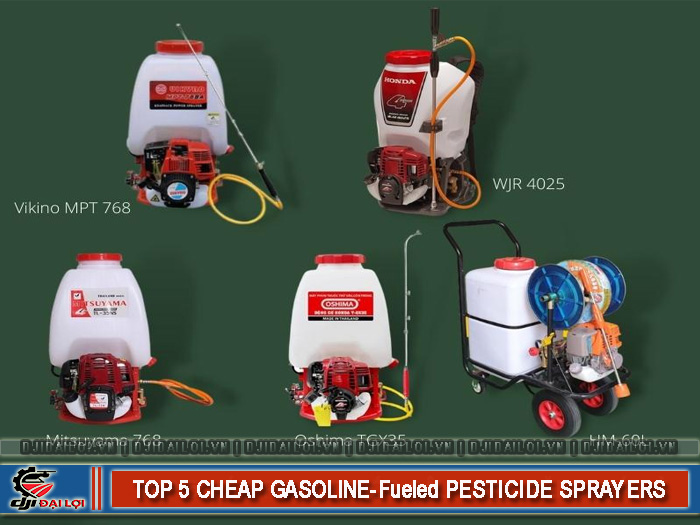
The price of gasoline pesticide sprayers ranges from 2,000,000 to 8,000,000 VND, depending on the brand, power, and tank capacity. Budget models under 3,500,000 VND are suitable for household use, while premium options above 5,000,000 VND target large-scale farming.
Farmers increasingly prefer gasoline sprayers for their long-range spray capability and fast coverage on large areas. The 4-stroke engines are favored for fuel efficiency and lower noise. Backpack sprayers with 16–25L tanks dominate the market thanks to their portability. Some farmers now combine them with agricultural drones for larger areas, marking a shift toward modern mechanized farming.
Advantages: strong power, high spray pressure, suitable for tall trees and wide fields.
Disadvantages: heavier than electric models, requires fuel and regular maintenance.
Still, for farmers seeking fast results and wide coverage, it remains the optimal choice.
When selecting an affordable gasoline-powered sprayer, consider engine power, tank size, brand reputation, and operating costs. Choose a model suitable for your garden size to save upfront costs while ensuring long-term spraying efficiency.
Gasoline models usually start from 1HP, spraying 10–15 meters away.
A 16–25L tank suits household needs best. Prioritize thick, durable plastic tanks with clear measurement marks and sturdy straps. Compact designs with padded shoulders or anti-vibration frames increase comfort during long working hours.
Honda GX25, Oshima, Stihl, Royal, and Makita are reliable brands known for spare parts availability, clear warranty policies, and durability. Avoid unbranded products with unclear origins to prevent costly breakdowns.
Beyond the machine price, users should account for fuel, oil changes, and maintenance.
4-stroke models save more fuel and emit less smoke than 2-stroke, making them better for sustainable farming. Regular cleaning and oil changes extend lifespan and reduce extra costs.
Here are five high-rated gasoline sprayers priced between 2–7 million VND, ideal for households and small farms - durable, fuel-saving, and easy to maintain.
→ Ideal for households seeking compact, low-cost machines.
→ Great for users wanting genuine Honda quality and fuel efficiency.
→ Popular among medium-sized farms needing high performance.
→ Suitable for families seeking an easy-to-use, low-cost sprayer.
→ Best for large gardens, reduces fatigue during long use.
To buy authentic gasoline-powered sprayers, choose local hardware stores, official dealers, or verified online marketplaces. Always check warranty terms, clear origin, and after-sales service. Among trusted distributors, DJI Đại Lợi stands out for offering genuine agricultural equipment with transparent pricing and professional technical support.
Agricultural equipment shops offer common models and quick transactions, though prices may vary by region. Compare several stores before purchasing.
Official distributors for Honda, Oshima, Stihl, Royal, etc., guarantee quality, stable pricing, and professional after-sales service.
Platforms like Shopee, Lazada, and Tiki offer competitive prices. Choose official stores or Mall listings and read customer reviews and return policies carefully before ordering.
To ensure efficient operation, start correctly, maintain regularly, and mix fuel at the proper ratio. Safe operation helps extend machine life, reduce fuel waste, and protect user health.
Choosing the right affordable gasoline pesticide sprayer helps reduce initial investment while maintaining effective farming performance. Each of the five models above offers distinct advantages - from portability and fuel savings to strong performance. Evaluate your garden size and budget carefully for the smartest purchase.
Yes. Its strong power and long range allow deep and even spray coverage, ideal for tall, wide-canopy fruit trees.
At 7–9 L/min flow, a full tank is sprayed in about 3–4 minutes, depending on throttle level and nozzle type.
Absolutely. Many households and facilities use them for spraying disinfectants in livestock areas or public spaces, provided safe chemicals are used.
2-stroke engines are louder, while 4-stroke ones run quieter and vibrate less - suitable for residential use. Earplugs are recommended.
Clean the air filter after 10–15 hours of use and replace it every 6–12 months. Check and replace spark plugs if ignition weakens or starting becomes difficult.